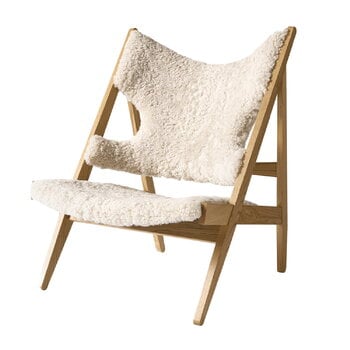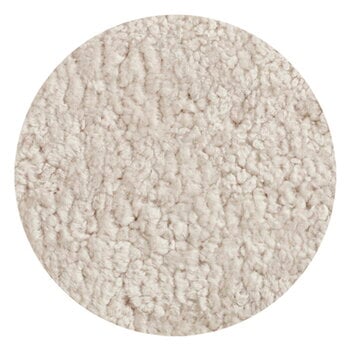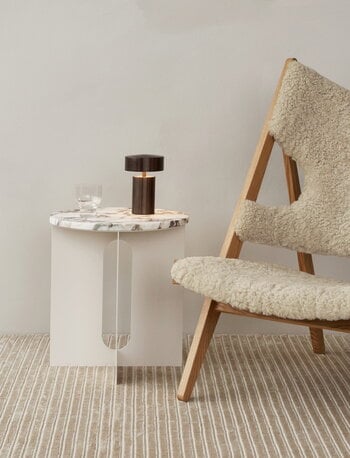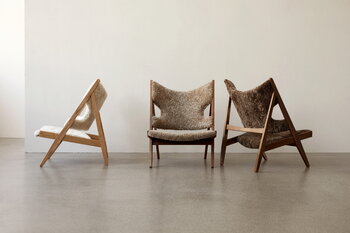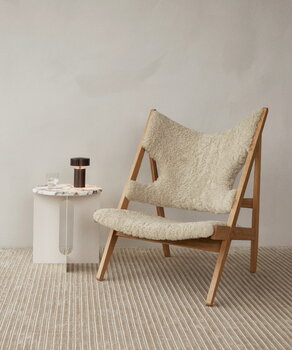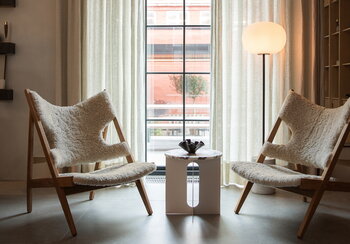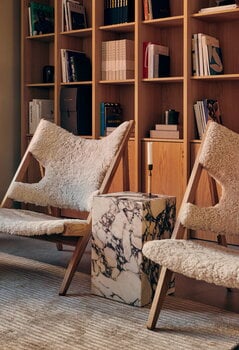Audo Copenhagen's Knitting Chair by Ib Kofod-Larsen is a cleverly designed lounge chair from 1951. A combination of an airy solid wood frame and a seat upholstered in genuine sheepskin, the Knitting Chair breathes a playful lightness of mid-century modernism from every angle. The chair was named for the elbow cut-outs designed to support arms when knitting – or reading a book or browsing a phone. Audo Copenhagen has relaunched the Knitting Chair under the Modernism Reimagined collection.
Knitting Chair, oak - Nature sheepskin
Audo Copenhagen
Description
Audo Copenhagen's Knitting Chair by Ib Kofod-Larsen is a cleverly designed lounge chair from 1951. A combination of an airy solid wood frame and a seat upholstered in genuine sheepskin, the Knitting Chair breathes a playful lightness of mid-century modernism from every angle. The chair was named for the elbow cut-outs designed to support arms when knitting – or reading a book or browsing a phone. Audo Copenhagen has relaunched the Knitting Chair under the Modernism Reimagined collection.
Product details (10)
- Colour
- Natural oak, light beige
- Width
- 71.3 cm
- Depth
- 66.9 cm
- Height
- 90.6 cm
- Seat height
- 30 cm
- Frame material
- Wax-oiled solid oak
- Seat cushion
- CAL117 foam
- Backrest cushion
- CAL117 foam
- Upholstery fabric
- Nevotex sheepskin Curly / Nature
- Weight
- 11 kg
- Product ID
Designer
Ib Kofod-Larsen (1921-2003) was one of the pioneers of the Danish modern in the 1950s. Kofod-Larsen received his architecture degree from the Royal Danish Academy, and he also worked as a designer – one of his best-known works is the Knitting Chair from 1951. Rather than a regional phenomenon, Kofod-Larsen saw Scandinavian design as part of international modernism, and he became one of the best-selling Danish architects in the United States in the 1950s. He also collaborated with many furniture manufacturers in the US, Europe and Japan.
View all productsReviews (0)
Sustainability
The Product Sustainability Framework, our criteria of sustainable design, helps you find the most sustainable products in our selection. Read below which sustainability criteria this product has met.
Working conditions & labour 7/9
-
Equal opportunities for all employees
-
Commitment to UN Global Compact, fair compensation for all employees
-
Corporate responsibility requirements defined and communicated for suppliers
-
Systematic work for improved inclusion and well-being in the workplace
-
Transparent supply chain
-
Suppliers' compliance to a code of conduct ensured
-
Compliance to the UN Guiding Principles on Business and Human Rights ensured in the supply chain
-
Direct suppliers audited and certified
-
Support for community involvement in the supply chain
Eco-friendly production 8/9
-
Fair and resource-wise water-use in production
-
No incineration or landfilling of returned items
-
No use of endangered species as materials
-
No direct environmental emissions or waste (excl. GHGs) from production
-
The sustainability of direct suppliers' production is addressed and monitored
-
Production and material sourcing that respect biodiversity, animal rights, and natural ecosystems
-
Material-efficient and ecological packaging
-
No potentially harmful chemicals used in own production
-
Positive impact on nature’s well-being through operations that regenerate natural ecosystems
Climate impact 4/8
-
Company's direct greenhouse gas emissions identified and commitment to reduction
-
Product's carbon impact identified and commitment to reduction
-
Guidance on energy- and eco-efficient use of the product
-
Carbon footprint of the product calculated and goals set to reduce it
-
Contribution to climate initiatives beyond the brand’s direct operations
-
Low-carbon or compensated transportation
-
100 % renewable energy in own production and operations
-
Carbon neutral or carbon negative product
Sustainable materials 5/6
-
Sustainable and long-lasting material choices
-
No harmful or hazardous substances
-
Responsible raw material sourcing and production
-
Ecological materials: natural, biodegradable, recyclable or recycled contents
-
Outstanding materials in terms of innovativeness, responsibility, sustainability and circularity: local production or sourcing, 100 % recycled content, C2C-certification etc.
-
Materials suited for circularity: monomaterials, recyclable finishings, renewable or recycled contents etc.
Circular design 4/5
-
High aesthetic quality promoting long-term use of the product
-
Technically durable product design and material choices
-
Design for enduring life-long quality
-
Design and support for product maintenance, repair and upgradability
-
Innovative circular design solutions: circular service system, resale platform, remanufacturing, collection of used products, etc.
